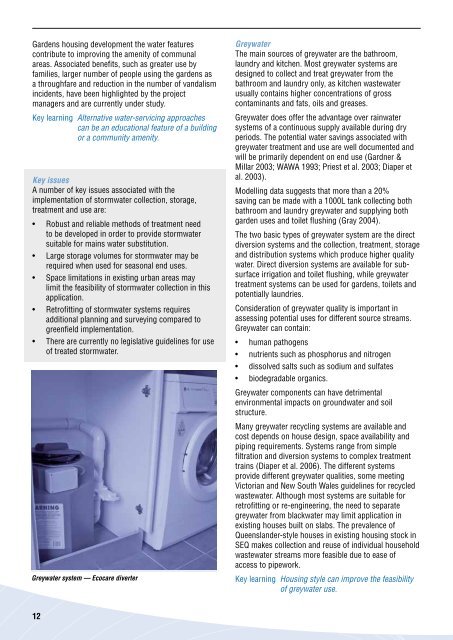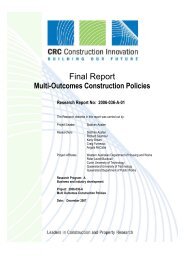Sustainable subdivisions - Construction Innovation
Sustainable subdivisions - Construction Innovation
Sustainable subdivisions - Construction Innovation
- No tags were found...
You also want an ePaper? Increase the reach of your titles
YUMPU automatically turns print PDFs into web optimized ePapers that Google loves.
Gardens housing development the water featurescontribute to improving the amenity of communalareas. Associated benefi ts, such as greater use byfamilies, larger number of people using the gardens asa throughfare and reduction in the number of vandalismincidents, have been highlighted by the projectmanagers and are currently under study.Key learning Alternative water-servicing approachescan be an educational feature of a buildingor a community amenity.Key issuesA number of key issues associated with theimplementation of stormwater collection, storage,treatment and use are:• Robust and reliable methods of treatment needto be developed in order to provide stormwatersuitable for mains water substitution.• Large storage volumes for stormwater may berequired when used for seasonal end uses.• Space limitations in existing urban areas maylimit the feasibility of stormwater collection in thisapplication.• Retrofi tting of stormwater systems requiresadditional planning and surveying compared togreenfi eld implementation.• There are currently no legislative guidelines for useof treated stormwater.Greywater system — Ecocare diverterGreywaterThe main sources of greywater are the bathroom,laundry and kitchen. Most greywater systems aredesigned to collect and treat greywater from thebathroom and laundry only, as kitchen wastewaterusually contains higher concentrations of grosscontaminants and fats, oils and greases.Greywater does offer the advantage over rainwatersystems of a continuous supply available during dryperiods. The potential water savings associated withgreywater treatment and use are well documented andwill be primarily dependent on end use (Gardner &Millar 2003; WAWA 1993; Priest et al. 2003; Diaper etal. 2003).Modelling data suggests that more than a 20%saving can be made with a 1000L tank collecting bothbathroom and laundry greywater and supplying bothgarden uses and toilet fl ushing (Gray 2004).The two basic types of greywater system are the directdiversion systems and the collection, treatment, storageand distribution systems which produce higher qualitywater. Direct diversion systems are available for subsurfaceirrigation and toilet fl ushing, while greywatertreatment systems can be used for gardens, toilets andpotentially laundries.Consideration of greywater quality is important inassessing potential uses for different source streams.Greywater can contain:••••human pathogensnutrients such as phosphorus and nitrogendissolved salts such as sodium and sulfatesbiodegradable organics.Greywater components can have detrimentalenvironmental impacts on groundwater and soilstructure.Many greywater recycling systems are available andcost depends on house design, space availability andpiping requirements. Systems range from simplefi ltration and diversion systems to complex treatmenttrains (Diaper et al. 2006). The different systemsprovide different greywater qualities, some meetingVictorian and New South Wales guidelines for recycledwastewater. Although most systems are suitable forretrofi tting or re-engineering, the need to separategreywater from blackwater may limit application inexisting houses built on slabs. The prevalence ofQueenslander-style houses in existing housing stock inSEQ makes collection and reuse of individual householdwastewater streams more feasible due to ease ofaccess to pipework.Key learning Housing style can improve the feasibilityof greywater use.12
















